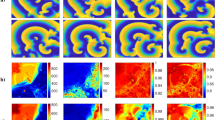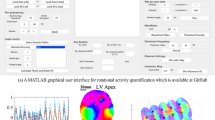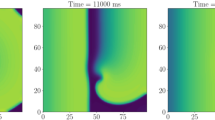Abstract
Sudden cardiac death is the leading cause of death in the industrialized world, with the majority of such tragedies being due to ventricular fibrillation1. Ventricular fibrillation is a frenzied and irregular disturbance of the heart rhythm that quickly renders the heart incapable of sustaining life. Rotors, electrophysiological structures that emit rotating spiral waves, occur in several systems that all share with the heart the functional properties of excitability and refractoriness. These re-entrant waves, seen in numerical solutions of simplified models of cardiac tissue2, may occur during ventricular tachycardias3,4. It has been difficult to detect such forms of re-entry in fibrillating mammalian ventricles5,6,7,8. Here we show that, in isolated perfused dog hearts, high spatial and temporal resolution mapping of optical transmembrane potentials can easily detect transiently erupting rotors during the early phase of ventricular fibrillation. This activity is characterized by a relatively high spatiotemporal cross-correlation. During this early fibrillatory interval, frequent wavefront collisions and wavebreak generation9 are also dominant features. Interestingly, this spatiotemporal pattern undergoes an evolution to a less highly spatially correlated mechanism that lacks the epicardial manifestations of rotors despite continued myocardial perfusion.
This is a preview of subscription content, access via your institution
Access options
Subscribe to this journal
Receive 51 print issues and online access
$199.00 per year
only $3.90 per issue
Buy this article
- Purchase on Springer Link
- Instant access to full article PDF
Prices may be subject to local taxes which are calculated during checkout




Similar content being viewed by others
References
Myerburg, R. J. et al. in Cardiac Electrohysiology, From Cell to Bedside (eds Zipes, D. P. & Jalife, J.) 666–678 (W. B. Saunders, Philadelphia, (1990)).
Holden, A. V. The restless heart of a spiral. Nature 387, 655–657 (1997).
Winfree, A. T. Electrical turbulence in three-dimensional heart muscle. Science 266, 1003–1006 (1994).
Panfilov, A. V. & Holden, A. V. (eds) Computational Biology of the Heart (Wiley, Chichester, (1997)).
Gray, R. A. et al. Mechanisms of cardiac fibrillation. Science 270, 1222–1225 (1995).
Lee, J. J. et al. Reentrant wave fronts in Wiggers' stage II ventricular fibrillation: characteristics and mechanisms of termination and spontaneous regeneration. Circ. Res. 78, 660–675 (1996).
Rogers, J. M., Huang, J., KenKnight, B. H., Smith, W. M. & Ideker, R. E. Stationary reentrant circuits are rare during ventricular fibrillation in pigs. Circulation 94, I–48 (1996).
Gray, R. A. & Jalife, J. Self-organized drifting spiral waves as a mechanism for ventricular fibrillation. Circulation 94, I–48 (1996).
Pertsov, A. M., Davidenko, J. M., Salomonsz, R., Baxter, W. T. & Jalife, J. Spiral waves of excitation underlie reentrant activity in isolated cardiac muscle. Circ. Res. 72, 631–650 (1993).
Winfree, A. T. When Time breaks down 40, 292 (Princeton Univ. Press, Princeton, NJ, (1987)).
Wiggers, C. J. Studies of ventricular fibrillation produced by electric shock. II. Cinematographic and electrocardiographic observations of the natural process in the dog's heart. Its inhibition by potassium and the revival of coordinated beats by calcium. Am. Heart J. 5, 351–365 (1930).
Witkowski, F. X. et al. Amethod for visualization of ventricular fibrillation: design of a cooled fiberoptically coupled image intensified CCD data acquisition system incorporating wavelet shrinkage based adaptive filtering. Chaos 8, 94–102 (1998).
Chen, P.-S. et al. Mechanism of ventricular vulnerability to single premature stimuli in open-chest dogs. Circ. Res. 62, 1191–1209 (1988).
Witkowski, F. X., Plonsey, R., Penkoske, P. A. & Kavanagh, K. M. Significance of inwardly directed transmembrane current in determination of local myocardial electrical activation during ventricular fibrillation. Circ. Res. 74, 507–524 (1994).
Russ, J. C. The Imaging Processing Handbook 2nd edn 157–158 (CRC Press, New York, (1994)).
Acknowledgements
We acknowledge support from MRC grants (to F.X.W., P.A.P., L.J.L. and W.R.G.), the Alberta Heritage Foundation for Medical Research (F.X.W. and W.R.G.), the Office of Naval Research Physical Sciences Division (M.L.S. and W.L.D.), the NSWC ILIR program (M.L.S.), the Georgia Research Alliance (W.L.D.) and the National Science Foundation (A.T.W.).
Author information
Authors and Affiliations
Corresponding author
Supplementary Information
Rights and permissions
About this article
Cite this article
Witkowski, F., Leon, L., Penkoske, P. et al. Spatiotemporal evolution of ventricular fibrillation. Nature 392, 78–82 (1998). https://doi.org/10.1038/32170
Received:
Accepted:
Issue Date:
DOI: https://doi.org/10.1038/32170
This article is cited by
-
When do chemical synapses modulate the formation of spiral waves?
Nonlinear Dynamics (2023)
-
Topological turbulence in the membrane of a living cell
Nature Physics (2020)
-
Unstable cardiac multi-spiral waves in a FitzHugh–Nagumo soliton model under magnetic flow effect
Nonlinear Dynamics (2020)
-
Generation of ECG signals from a reaction-diffusion model spatially discretized
Scientific Reports (2019)
-
Wave emission from heterogeneities with changing boundary curvature and orientation by a circularly polarized electric field in cardiac tissues
Nonlinear Dynamics (2019)
Comments
By submitting a comment you agree to abide by our Terms and Community Guidelines. If you find something abusive or that does not comply with our terms or guidelines please flag it as inappropriate.



